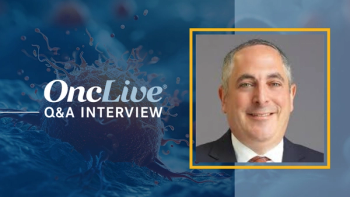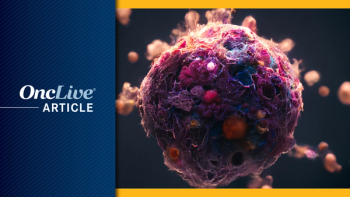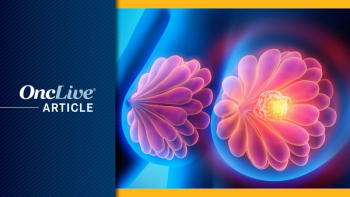
Intensive Chemotherapy Falls a Few Steps Behind in Leukemia and Lymphoma

Naval Daver, MD, discusses the latest developments in acute lymphoblastic leukemia, chronic lymphocytic leukemia, acute myeloid leukemia, and follicular lymphoma.
The management of acute and chronic leukemias and lymphoma is becoming less reliant on intensive chemotherapy, explained Naval Daver, MD, who added that this paradigm shift has reflected a greater dependence instead on antibody-drug conjugates, BTK inhibitors, and FLT3/IDH inhibitors.
“The overarching theme was that we really have moved away from intensive chemotherapy in a large proportion of patients, whether it’s with CLL [chronic lymphocytic leukemia], or with follicular lymphoma, or even in ALL [acute lymphoblastic leukemia]. In AML [acute myeloid leukemia] we still are using [chemotherapy] for a number of younger patients, but more and more with the advent of the HMA [hypomethylating agent]/venetoclax [Venclexta] backbone and trying to add to that, we are seeing less and less use of intensive chemotherapy, even in the AML population,” Daver said in an interview with OncLive® following an Institutional Perspectives in Cancer webinar on hematologic malignancies.
In the interview, Daver, an associate professor in the Department of Leukemia and Division of Cancer Medicine at The University of Texas MD Anderson Cancer Center, discussed the latest developments in ALL, CLL, AML, and follicular lymphoma.
OncLive®:Elias Jabbour, MD, of The University of Texas MD Anderson Cancer Center, discussed current and emerging treatment approaches in ALL. Where has the field seen the most progress?
Daver: In ALL, Dr Jabbour showed emerging data integrating the antibody therapies, inotuzumab ozogamicin [Besponsa] as well as blinatumomab [Blincyto] into frontline treatment with low-dose chemotherapy [with] mini-CVD [cyclophosphamide, vincristine, and dexamethasone], where we’re now seeing very high remission rates, molecular MRD [minimal residual disease] clearance, as well as 3- and 4-year survival rates of close to 70% to 80%. These [regimens] can be given even in an older patient with ALL. This is a major improvement and really shows that even though inotuzumab ozogamicin and blinatumomab were approved as single agents, it appears that the best use of these agents to really improve the long-term cure rate may be to integrate them in a sequential approach in the frontline setting.
The other area that has had dramatic progress, probably the most progress in acute leukemias is in Philadelphia positive [Ph]–ALL. Just 20 years ago, the outcome was very poor, with a 5-year survival rate of about 25% to 30% and only in those patients with Ph-positive ALL who could make it to transplant. Now in Ph-positive ALL, we are seeing 5-year survival rates with hyper-CVAD [cyclophosphamide, vincristine, doxorubicin, and dexamethasone] and ponatinib [Iclusig] of 78%, so much improved. In fact, most patients who achieved a complete molecular clearance do not need to go to stem cell transplant.
Even more impressive now is that we are starting to see emerging data combining ponatinib with blinatumomab, so chemotherapy-free treatment based on a TKI and antibody, and the initial data are showing close to a 100% response rate with molecular clearance in 70% of patients. We do not have 5-year follow-up, but it does look like this approach may result in a complete chemotherapy-free treatment for Ph-positive ALL, which just 20 years ago had a very poor outcome, and today could be cured without intensive chemotherapy or without transplant. We have seen a huge paradigm shift over the years for this disease subset.
Jan Burger, MD, PhD, of The University of Texas MD Anderson Cancer Center, discussed updates in the management of CLL. Where have BTK inhibitors had the greatest impact?
In CLL, Dr Burger discussed the BTK inhibitors, which represent a major step [forward] in CLL. Ibrutinib [Imbruvica] was the first BTK inhibitor that was approved. There are multiple BTK inhibitors now, including acalabrutinib [Calquence], zanubrutinib [Brukinsa], and most recently pirtobrutinib.
With the BTK inhibitors alone in frontline CLL, including in certain high-risk subsets, we are now seeing 5-year disease-free survival [DFS] rates of close to 80%. These are oral and outpatient and extremely well tolerated. We’re seeing more and more patients with CLL now dying from natural causes and not from the disease. We also have almost completely stopped doing stem cell transplant in the general population of CLL, although we still do it for the more advanced forms of CLL, such as Richter’s transformation and blastic CLL.
Also, there were a lot of discussions about the use of ibrutinib alone as a single agent vs potentially combining ibrutinib with the BCL-2 inhibitor venetoclax, which has also shown activity and is approved in CLL. Some of the data presented by my colleague Dr Nitin Jain and published in the New England Journal of Medicine shows that the combination of ibrutinib and venetoclax gives us very high MRD-negative responses up to 80% compared with only 20% to 25% that can be seen with ibrutinib alone, and that at 2 years, most patients can stop treatment and maintain long-term DFS.
This is really encouraging because we may now be able to convert CLL from a chronic disease to potentially one where we can stop treatment and still have people maintaining a remission, and that’s being looked at in a randomized study.
There was also discussion about some of the other new approaches in CLL. There are certain CAR T cells and CAR NK cells that are emerging and are early on in development. All in all, it looks like CLL could be potentially, in the next few years, a highly curable disease, with most patients having a routine survival.
Loretta Nastoupil, MD, of The University of Texas MD Anderson Cancer Center, discussed the state of treatment in follicular lymphoma. What agents are being used to reduce the use of chemotherapy in this population?
Dr Nastoupil discussed follicular lymphoma. Like CLL, we are seeing improved outcomes with the incorporation of antibodies, as well as with combinations such as lenalidomide [Revlimid] and rituximab [Rituxan], again a chemotherapy-free regimen that is showing very high response rates and very good durability of response. It has been challenging to develop CAR T cells in follicular lymphoma and CLL, because of the success of the lower intensity, better tolerated treatments that are already giving us higher response rates and very prolonged disease control rates.
You discussed some of the shifts in AML treatment in your presentation. What have been the most significant changes to date?
In AML, which remains among these 4 diseases, one of the most difficult, we have also had a lot of progress with 9 new drugs approved. I discussed some of the key indications for these new therapies. The emergence of HMAs and venetoclax as a new backbone to build on in AML therapy is probably the biggest change that has occurred. Historically in older unfit AML, the 5-year survival rate was less than 10%. Today, with the emergence of HMAs/venetoclax, we’re doing better and getting close to 30% to 35%. Of course, there’s still room for improvement.
The next stage of clinical development and progress will be to see how we can use preclinical data and rationally [evaluate] the addition of drugs to the HMA/venetoclax backbone. In fact, at the 2021 ASH Annual Meeting and Exposition, the theme in AML was the development of triplets. These trials are all quite early and, of course, randomized studies are just starting, but it does look like adding FLT3 inhibitors like gilteritinib [Xospata] or quizartinib, or IDH inhibitors, or even CD47 antibodies to the backbone of HMA/venetoclax is giving us higher true complete response rates, higher MRD negativity, and hopefully this will translate into improved overall survival.
Some of these triplets could get us to a point where we could start seeing 3- and 5-year survival rates of 60% or higher, just like in follicular lymphoma, as well as in CLL. In AML, we will start to challenge intensive chemotherapy. We’re still 4 or 5 years away from that, but potentially with some of the FLT3-, IDH-, CD47-, and TP53-directed triplets, we may be able to replace intensive chemotherapy, even for younger patients. There are a lot of interesting developments to come in the next 4 to 5 years in AML.
All in all, personalization of therapies is here. We talked about it for 20 to 30 years, but now, we really have selection based on mutations, especially in AML where we probably have the best molecular targeted approaches with FLT3 and IDH inhibitors, now with menin inhibitors targeting NPM1 and MLL, and in 8 to 10 years from now, AML will be viewed as 7 or 8 completely different diseases, depending on the mutation and the targeted therapy. That is fine if we can continue to improve the outcomes, response rates, and survival for patients.

























































































